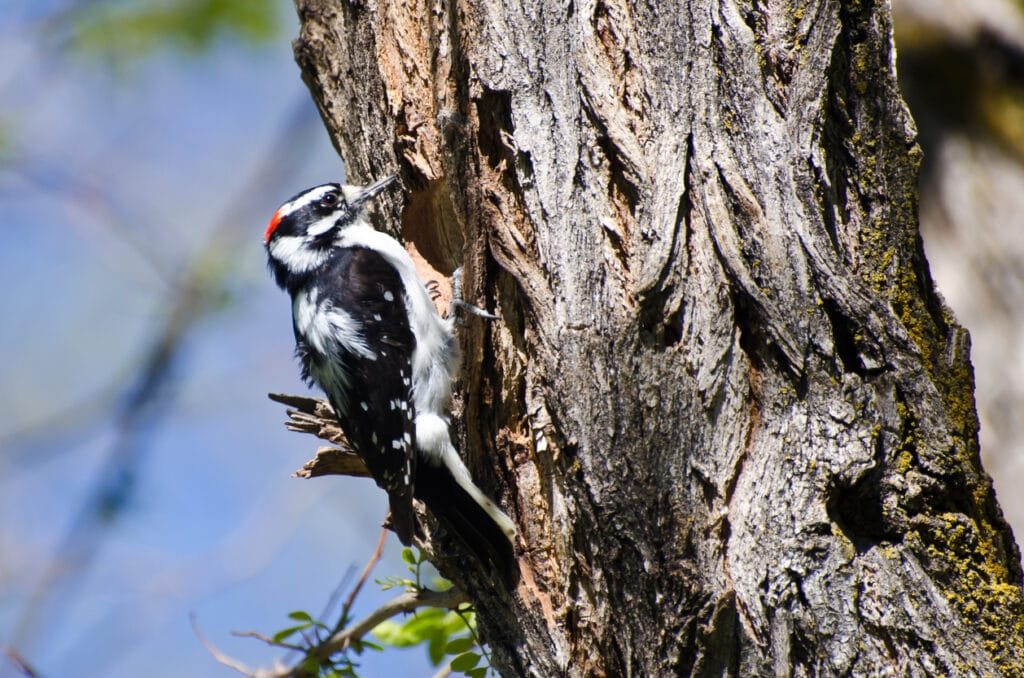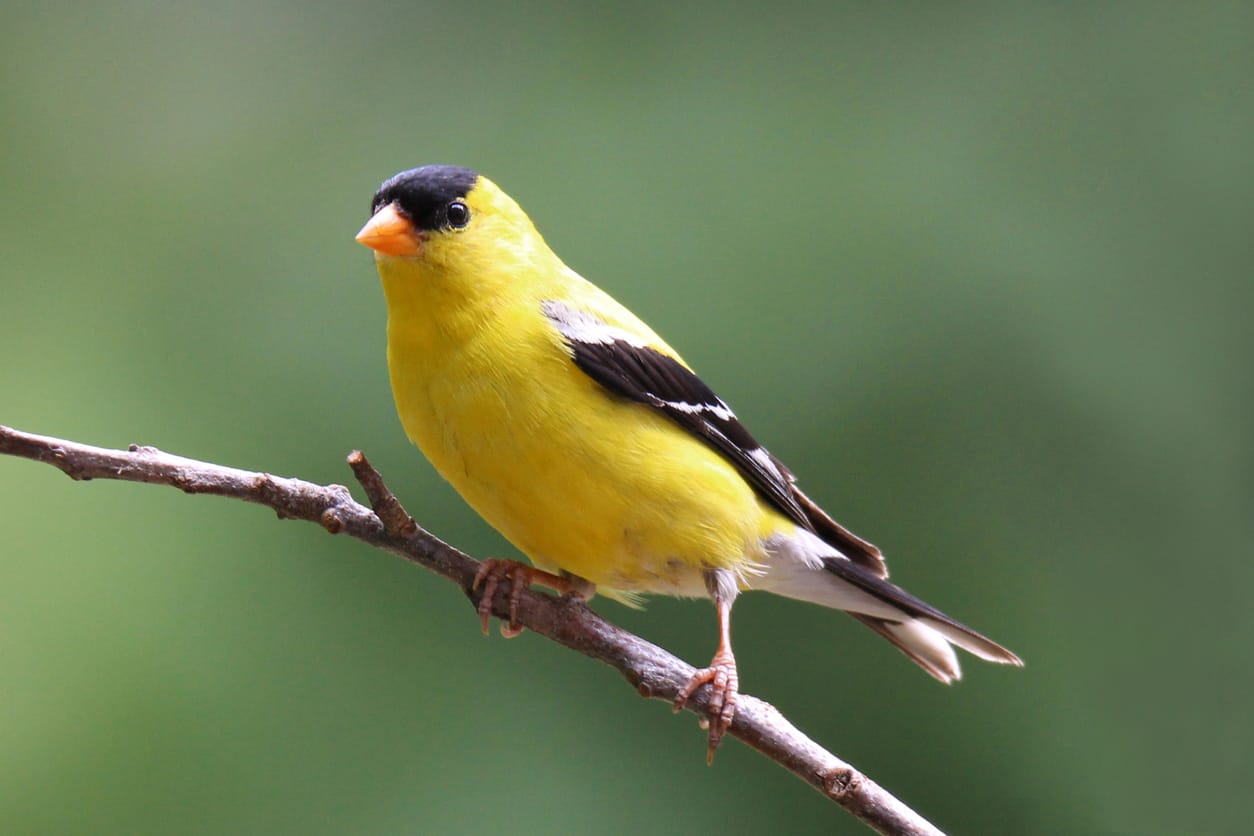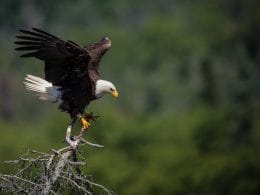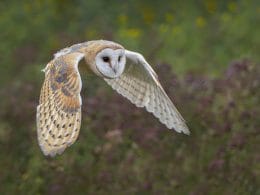The name of the State of Iowa comes from the Ioway people, one of the region’s native tribes. In their language, Iowa means beautiful, and the name still sticks because of the state’s beautiful landscape and landmarks.

Also known as the Hawkeye State, the history of Iowa goes back to a Native American warrior named Black Hawk or Hawkeye.
But if you’re not interested in history and prefer to go birdwatching, Iowa will be the right spot for you.
It’s home to 431 bird species that live in the state permanently or visit occasionally. And in this article, we’ll talk about the most famous birds in Iowa.
So, let’s dive in.
16 Most Common Birds in Iowa
In this section, we’ll talk about 16 birds that you can see in Iowa.
1. American Goldfinch

- Scientific Name: Spinus tristis
- Length: Between 4.3 and 5.5 inches
- Weight: Between 0.39 and 0.71 ounces
- Wingspan: Between 7.5 and 8.7 inches
Additional Information
The American Goldfinch is Iowa’s state bird and can be found in the weedy fields, parks, and backyards. But it prefers overgrown areas with some shrubs for nesting. it’s one of the most common species of birds in Iowa.
Author Note: It’s an all-bright bird with black wings and a black patch on its face. The bird molts its feathers twice a year, and the bright plumage announces the arrival of spring.
This bird feeds on seeds from grass and trees and will be attracted to your backyard if you fill your feeder with sunflower and Nyjer seeds. It’s one of the strictest vegetarian birds and will only swallow an insect by mistake.
2. Common Starling

- Scientific Name: Sturnus vulgaris
- Length: Between 7.5 and 9.1 inches
- Weight: Between 2 and 3.6 ounces
- Wingspan: Between 12 and 17 inches
Additional Information
The Common Starling is usually found in the hidden cracks in trees, and the large flocks can be very aggressive. This bird looks black from a distance, but when you get closer, you’ll be able to see the purple-green iridescent plumage.
Despite being annoying, people love watching these beautiful birds. The Common Starling, also known as the European Starling, often comes to bird feeders. It’s another very common species of birds in Iowa.
All the birds present in North America are descendants of 100 birds that were released in Central Park in 1890. The Common Starling feeds on anything but prefers insects and invertebrates, and it’s a strong bird that can reach up to 48 miles per hour while flying.
3. American Robin

- Scientific Name: Turdus migratorius
- Length: Between 9 and 11 inches
- Weight: About 2.7 ounces
- Wingspan: Between 12 and 16 inches
Additional Information
The American Robin is likely to be found in the forests of Iowa during winter, where it can find some grapes and cherries. Otherwise, it’s quite rare to find because it can’t get the earthworms and snails it feeds on.
The bird is grayish-brown with a bright orange chest, and it’s a common guest at backyard feeders. When it can’t find worms, the American Robin will look for fruits with bugs and worms in them.
Top Tip: In winter, the American Robin will roost in big flocks, where each flock can be made of up to 250,000 birds.
4. House Finch

- Scientific Name: Haemorhous mexicanus
- Length: Between 5 and 6 inches
- Weight: Between 0.6 and 0.9 ounces
- Wingspan: Between 8 and 10 inches
Additional Information
The House Finch is found in Iowa all year long and can be found in several habitats like parks and gardens. Male and female birds look different, where the males are bright rosy red while the females are dull gray-brown. It’s another very common species of birds in Iowa.
This bird feeds on plants, fruits, and seeds and will get attracted to your backyard feeder if you fill it with black oil sunflower seeds. The bird’s diet and age affect the brightness of its plumage.
5. Northern Cardinal

- Scientific Name: Cardinalis cardinalis
- Length: Between 8.3 and 9.1 inches
- Weight: Between 1.9 and 2.29 ounces
- Wingspan: Between 9.8 and 12.2 inches
Additional Information
The Northern Cardinal is commonly found in Iowa, especially around forest edges. It’s a big songbird with a bright red body and black feathers that outline the bill.
A lot of people see the Northern Cardinal attacking its reflection in a window, especially because both males and females are highly territorial. It mainly feeds on seeds, fruits, and insects.
6. Downy Woodpecker

- Scientific Name: Dryobates pubescens
- Length: Between 5.5 and 7.1 inches
- Weight: Between 0.7 and 1 ounces
- Wingspan: Between 9.8 and 12.2 inches
Additional Information
The Downy Woodpecker is a common woodpecker in Iowa, usually seen in parks, suburban backyards, cemeteries, and orchards. It has a small black body with a white belly and back and a checkered head. The male bird has a red patch on the head.
It’s a common guest at backyard feeders and will prefer suet feeders. But it will also accept black oil sunflower seeds, peanuts, millet, and peanut butter.
Top Tip: In winter, the Downy Woodpecker socializes with other bird species for better protection from predators. It mainly feeds on beetle larvae, ants, and caterpillars.
7. White-Breasted Nuthatch

- Scientific name: Sitta carolinensis
- Length: About 6.1 inches
- Weight: Between 0.63 and 1.06 ounces
- Wingspan: Between 7.9 and 10.6 inches
Additional Information
The White-Breasted Nuthatch usually lives in the deciduous forests, but it adapted to the presence of humans and currently lives in parks and near backyards in Iowa. It’s a gray-blue bird with a white face, and it gets its name from the habit of hiding nuts in large tree crevices.
It’s a territorial bird, and pairs stay together all year long. It starts foraging at the top of trees and goes down to look for wood-boring beetle larvae, treehoppers, and scale insects.
When you fill your feeder with seeds, this little bird is likely to go from and to the feeder several times. This means that it’s storing food to eat later.
8. Indigo Bunting

- Scientific Name: Passerina cyanea
- Length: Between 4.5 and 5.9 inches
- Weight: About 0.5 ounces
- Wingspan: Between 7 and 9 inches
Additional Information
The Indigo Bunting is a common bird in the spring and summer, usually found in the woodland edges and hedgerows in less crowded towns. The male bird is bright blue, and the plumage gets darker on the head, while the female is brown with some blue feathers on the chest.
If you want to attract the Indigo Bunting to your backyard feeder, you need to fill it with small seeds like Nyjer and thistle. During the migration season, these birds migrate at night as they use the stars for guidance.
9. Red-Winged Blackbird

- Scientific Name: Agelaius phoeniceus
- Length: Between 6.7 and 9.4 inches
- Weight: Between 1.46 and 2.3 ounces
- Wingspan: Between 12.2 and 15.8 inches
Additional Information
The Red-Winged Blackbird is found around marshes and swamps and will visit your backyard for mixed grains. The male bird is all black with yellow and scarlet shoulder patches, while the female bird is brownish.
The birds have loud calls, but they don’t try to attract attention. The male bird usually has multiple female mates and spends most of its time defending its territory.
Author Note: In the summer, the Red-Winged Blackbird feeds on insects and can probe the bases of aquatic plants to find hidden insects. In winter, this bird feeds on weedy seeds.
10. Eastern Kingbird

- Scientific name: Tyrannus tyrannus
- Length: Between 7.5 and 9.1 inches
- Weight: Between 1.2 and 1.9 ounces
- Wingspan: Between 14 and 15 inches
Additional Information
The Eastern Kingbird has a blackish above and white below with a dark black head. It has a crown of yellow or orange feathers, but it usually keeps it concealed and reveals it only when attacked by a predator. It’s found around the marshes and tallgrass prairies of Iowa.
This is a summer resident of Iowa, and if you have nearby trees and berry bushes, it might visit your backyard. The Eastern Kingbird usually catches insects while they’re flying in the air. It feeds on wasps, beetles, bees, and grasshoppers.
When the Eastern Kingbird catches a big insect or a frog, it beats it on the side of the tree and then swallows it. It rarely drinks water and stays hydrated by feeding on insects and fruits.
11. Black-Capped Chickadee

- Scientific name: Poecile atricapillus
- Length: Between 4.7 and 5.9 inches
- Weight: Between 0.32 and 0.49 ounces
- Wingspan: Between 6.3 and 8.3 inches
Additional Information
The Black-Capped Chickadee is a common bird in Iowa. It has a tiny white, gray body and an oversized black head with white cheeks.
It will be a common guest at your bird feeder if you fill it with sunflower seeds, peanuts, or suet. Planting alder, willow, and birch trees will also attract this bird because it feeds on seeds, berries, and other plant matter.
The Black-Capped Chickadee has a small brain, so each winter, it lets the neurons that carry old information die and then grow new neurons with new information. This is how this little bird adapts to the changes in its environment.
12. Blue Jay

- Scientific Name: Cyanocitta cristata
- Length: Between 9 and 12 inches
- Weight: Between 2.5 and 3.5 ounces
- Wingspan: Between 13 and 17 inches
Additional Information
The Blue Jay is an all-year resident of Iowa. It’s a blue bird with some black feathers and a white below, and it’s easily detected, thanks to its loud and noisy calls.
This bird prefers tray and hopper feeders and will feed on suet, peanuts, and sunflower seeds. It also appreciates the presence of a birdbath.
Top Tip: When there’s a hawk nearby, the Blue Jay will imitate its call to notify the other birds of the predator’s presence.
13. Yellow-Billed Cuckoo

- Scientific Name: Coccyzus americanus
- Length: Between 10.2 and 11.8 inches
- Weight: Between 1.9 and 2.3 ounces
- Wingspan: Between 15 and 16.9 inches
Additional Information
The Yellow-Billed Cuckoo prefers to hide in dense leafy groves and deciduous woodlands. It’s a fairly large, long, and slim bird with warm brown above and white below with some rufous feathers on the wings.
You can hear this bird in summer, but it’s usually hard to spot. And it mainly feeds on caterpillars. It also feeds on beetles, ants, white-marked tussock moths, cicadas, and even frogs and lizards. In winter, it prefers to feed on seeds and fruits.
It’s a more rare species of birds in Iowa.
14. Red-Bellied Woodpecker

- Scientific Name: Melanerpes carolinus
- Length: Between 9 to 10.5 inches
- Weight: Between 2 and 3.2 ounces
- Wingspan: Between 15 and 18 inches
Additional Information
The Red-Bellied Woodpecker is pale with a checkered back and a bright red cap. It’s common in woodlands and forests but can also be seen visiting your bird feeder if you fill it with suet, sunflower seeds, and peanuts.
You can most probably notice the Red-Bellied Woodpecker, thanks to its rolling call. The bird’s tongue can stick out 2 inches past the beak’s end, and the barbed tongue allows it to catch insects from crevices.
Author Note: It prefers to feed on ants and spiders and sometimes feeds on nuts and acorns.
15. American Crow

- Scientific Name: Corvus brachyrhynchos
- Length: Between 16 and 21 inches
- Weight: Between 11.1 and 21.9 ounces
- Wingspan: Between 33 and 39 inches
Additional Information
The American Crow is all black and is usually found in big flocks of thousands of individuals. It can be found all across Iowa throughout the year.
This bird doesn’t usually visit bird feeders but will visit your backyard if there are lots of trees or you offer food. The American Crow will get attracted to garbage, compost, and the pet food you leave outside. It also feeds on mice, earthworms, berries, seeds, nuts, fruits, and berries.
16. Baltimore Oriole

- Scientific Name: Icterus galbula
- Length: Between 6.7 and 8.7 inches
- Weight: Between 0.79 and 1.48 ounces
- Wingspan: Between 9.1 and 12.6 inches
Additional Information
The Baltimore Oriole is found specifically in Eastern Iowa and becomes quite noticeable in late spring. It’s all flame-orange and black with a solid black head. It’s usually hard to see because it feeds high on trees in open woodlands, orchards, and backyards.
This bird prefers ripe fruits, so you can cut oranges in halves and hang them from trees to attract it.
The Baltimore Oriole also prefers dark-colored fruits like berries and cherries. It also feeds on insects and nectar.
Wrap Up
If you’re a bird lover, you have a chance to see lots of these amazing creatures in Iowa. Some of them might be located deep into the forest, but others will come and visit your backyard, so keep your bird feeder filled with food to attract a few.
We hope you enjoyed our guide on common birds in Iowa.
FAQ
The most common bird in Iowa is the American Crow.
Some birds that are native to Iowa include the Eastern Bluebird, the Eastern Towhee, and the Henslow’s Sparrow.
Some birds that stay in Iowa over the winter include the American Goldfinch, the Dark-eyed Junco, and the Tufted Titmouse.
The most common bird in Eastern Iowa is the American Robin.










